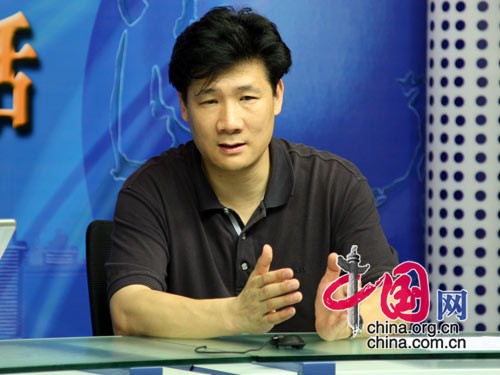
Jia Peng, director of publicity for the Beijing Subway Operation Co. Ltd, discussed in detail measures for subway safety on July 9, 2008.
China.org.cn:
We see that there are also some policemen and police dogs besides the instruments you have introduced.
Jia Peng:
That's right, since safety inspections are carried out by three groups of forces. The first is the Public Transportation Security Department of the Public Security Bureau. This team is responsible for public safety at the subway. Its major duty in the whole system of safety inspections is to execute laws and rules according to their requirements. The second is composed of all screeners we see. The subway corporation has recruited more than 3,100 screeners, whose major task is to help the police operate these machines, direct the flow of passengers and take responsibility for the publicity of safety inspections. The third is made up of the subway staff as well as security personnel. When the subway is in operation, they monitor the subway stations, halls, tunnels and carriages in real-time. If something that might cause danger happened, they would deal with it effectively in order to ensure a safe subway. Meanwhile, by using the video-monitoring system installed at subway stations, carriages, halls and hallways, they can learn about the flow of passengers at various public places in the subway and provide relevant information quickly for the police and security personnel. With these measures in place, the safety of passengers can be effectively ensured.
The three groups of forces form a network to protect the whole subway from danger. In an emergency, they will carry out their respective tasks effectively.
China.org.cn:
Now people are not allowed to take liquids on a plane. Will it also be forbidden to take liquids on the subway during the Olympic Games? Actually, there have been some measures to deal with that. People are concerned whether it will be forbidden in the future.
Jia Peng:
We made a clear announcement recently that there are also some limitations for liquids which can be taken on the subway, since they don't belong to the eight categories of prohibited items. However, poisonous liquids and liquids that are harmful to one's body, such as gasoline, alcohol, kerosene and sulfate, are completely different from water and beverages. Therefore, people should be clear that we have made a distinction between these types of liquids passengers take. People are allowed to take beverages, but they have to be selectively checked by a liquid detector to examine their ingredients. If they are found to be of no danger to the public, you can take them into the subway. It's quite difficult to judge whether the liquid itself is harmful, so we have to check it with a liquid detector.
During the Olympics, we must selectively inspect bottles of liquid which passengers take. The liquid detector can soon identify whether it is normal or poisonous. Recently we did an experiment. We took a mineral water bottle, with one-third water and two-thirds alcohol. If there is a certain alcohol concentration, the liquid detector can quickly recognize it. After detection, we cannot say it is harmful; instead, the staff has to open the bottle, observe and smell the liquid, and require the passenger to drink it. All these measures are taken to ensure that the liquid is not a threat to other passengers.